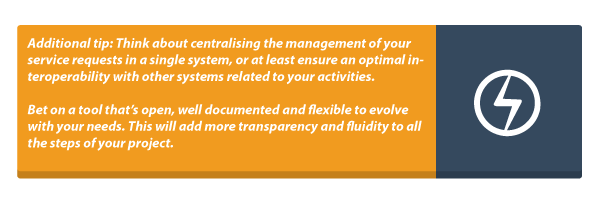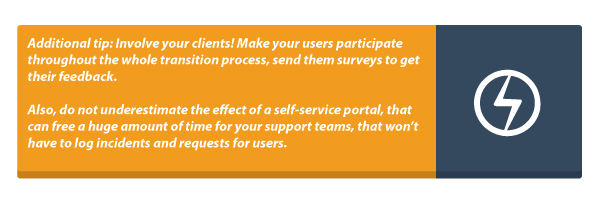Transition to a New Helpdesk in 5 Days!
After many years with your current helpdesk, it can no longer keep up with your needs, that have evolved. Worse, you may be trying to stay afloat and manage everything inside an Excel file or an email folder.
Don’t you have other priorities than having to constantly extinguishing fires (more than 50% of the time of support teams is spent resolving tickets (Source: HDI 2016 Technical support practices & salary)? You’re right to think that solutions exist.
You’re now looking for a system that will reduce the number of service requests and improve the quality of service for your users. Here’s a series of guidelines that will help you for the choice and the implementation of a new helpdesk, from Monday to Friday. *
Let’s begin our week.
Monday – Do the inventory of your needs
Sadly, the weekend has ended. Still, you drink your coffee and get back to work.
The first thing to do is analyze the current situation: Clarify your request management processes and do the inventory of those processes by determining their function and their role. What are the needs that will be filled by your new solution? Functional needs? Business needs? Specific technical requirements? Will you implement in a Cloud-Based mode or On-Premise? What other systems will you have to integrate with your new Helpdesk?
Here are some criteria that you can use to narrow the list of possible Helpdesks:
- Your internal IT needs (Knowledge Base, CMDB, etc.)
- The price of the Solution
- The licence model
- Work frame and Certifications (i.e. ITIL)
- The offered level of support
- The speed of implementation
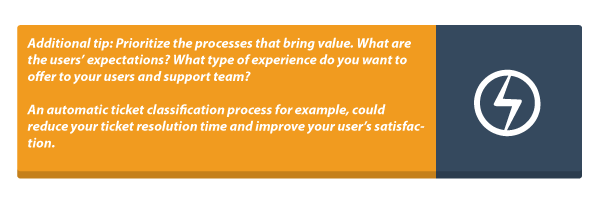
A Lean IT approach could be useful here. Divide your transition project in steps and attack those steps one by one. Keep everything as simple as possible, while making a list of the demands that you want and the ones that you need. Try to involve all parties that are concerned by this change process.
From the requirements that you’ve selected, you can now decide which IT service management (ITSM) provider and which solution to select, with the help of a tool like a decision matrix. The principle behind a decision matrix consists in weighting your decision criteria based on their importance and to rate each option (ITSM provider and/or solution) on those criteria. The option that obtains the highest score becomes the option that you should select. Make sure, however, to select the correct criteria for your matrix, for your choice to be representative of your needs.
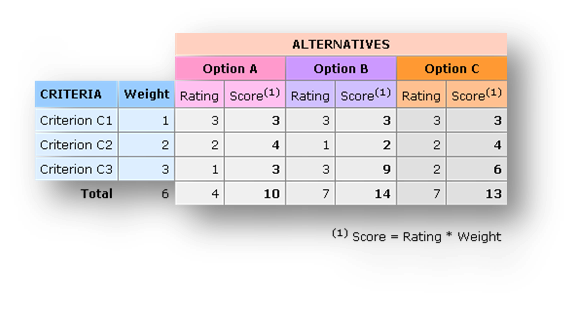
At the end of your first day of work. You’ve selected a software solution that meets the criteria that you’ve set and a provider that will accompany you efficiently through the implementation of the solution.
Tuesday – Prepare your implementation with these key points
With the basis now built, it is time to see what elements should be included in your transition to your new helpdesk.
For starters, the centre of your newly selected support tool should be the service catalog; the list of services that are offered to users in the helpdesk. Some services may be available only to some users, or requiring an approbation or the execution of specific tasks in a workflow. The options of how to configure your service catalog are up to you.
The language of your service catalog of your new solution should logically be the same that the one that’s used by your users, with the catalog using the right terms. Bring value to your users and your business with your new helpdesk; focus on the elements that will improve the satisfaction of your clients and of your support team.
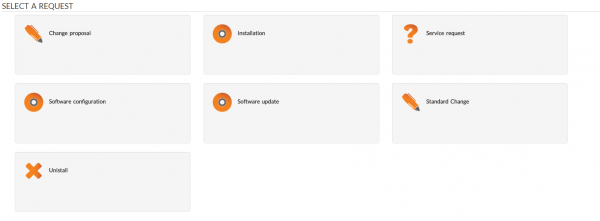
Criteria for a Service Catalog:
- Use a language that’s clear for the user
- Allow for decision-making
- Supported by IT
- Provide logical grouping
- Anticipate the evolutions and updates
- Open and transparent, aiming towards a better IT-User relationship
To improve customer satisfaction: we can think of bringing forward many means for clients to contact the support team, through mobile, email or phone. For your support team, give them tools that will help them resolve tickets faster, with the help of a Knowledge Base for example, containing previous resolutions of problems and incidents and information that will guide them through the handling of various service requests.
Far from what you can do in an Excel sheet right?
Among the other key points required to offer quality support, according to the organization that participated in the latest Help Desk Institute report, your new solution should provide, in addition to a knowledge base (55% of respondents believe it is essential for successful support), incident management (72%), Customer satisfaction surveys (37%), problem management (30%) and change management technologies (30%) to provide successful support. Fortunately, these can all be integrated inside your helpdesk.
Finally, an important element, if it’s not already implemented in your workplace, is the implementation and monitoring of SLAs (Service Level Agreement) inside your helpdesk. A SLA is a document describing and specifying the services and the service level provided by a 3rd party service provider. In your new helpdesk tool, having the capacity to visualize and analyze your SLAs with graphics and tables brings an indispensable added value. With this, you can react more quickly and better identify the elements that affect your SLAs.
The transparency and communication between all parties involved by your project is essential to the good proceeding of your new implementation project and is vital for every good change management process. Training and involving the users of the new software early and throughout the whole change process is also a good practice to take in such a change process.
An Agile work method here can help you subdivide your projects and follow the evolution of the changes throughout the steps of the change management process. Think about using a KISS method as well, to help you determine which elements from your old helpdesk tool to Keep, Improve, Stop and which new element to Start.
Wednesday – Careful, Avoid Hurdles!
Despite your best efforts, a transition generally doesn’t happen without a few problems.
In your workforce, there may be some resistance to change, that can be caused by a variety of factors; the fear of the unknown brought by the new solution, a loss of tasks and responsibilities or the arrival of other factors brought in by the change. Therefore, it is important to accompany those specialists and resources, who are impacted by the change and not forget them in the process. As mentioned before, you should not only involve them at the beginning of the process, but also throughout the whole process; let them participate by testing new software for instance. It is then useful to get their input and impressions and by doing so, create a synergy.
Another way to counter this resistance is to show the advantages and benefits of the change in the medium term and showcase all the possibilities of improvement that are brought by the change.
For a new helpdesk solution, those advantages can be, among other things, a lowered workload, a lower ticket volume and a faster ticket resolution time. Knowing this, your support agents will feel more involved, more efficient and useful for the organization.
Being careful is always recommended when transitioning to a new helpdesk or ITSM solution.
Make sure not to swallow an elephant all at once. Go one bite at a time instead, by working in an Agile mode, as mentioned above. This will avoid making mistakes, lower change resistance and will ultimately accelerate the transition.
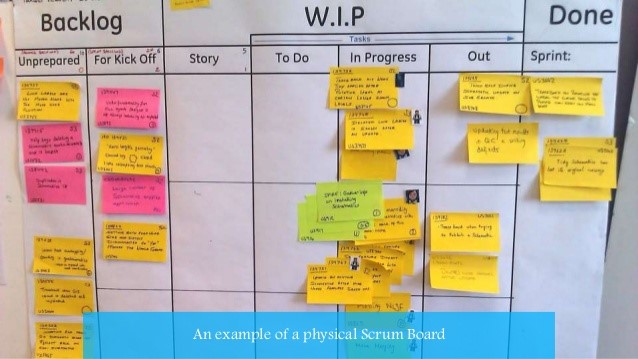
Thursday – Heading towards a successful implantation
You’ve worked hard, you’ve planned the transition and made sure to avoid hurdles. All there is left to do is to proceed.
Not so fast! You can’t underestimate the importance of leadership and communication in all of this;
- Take the time to meet with your teams, discuss and make sure that everyone is on the same page and has the same information about the changes.
- Talk about the difficulties that have been encountered during the transition towards the new helpdesk, the upcoming implementations and get the feedback from your users.
A tool transition inevitably brings a certain level of discomfort at the beginning, it’s like trying a new car a not being quite used to driving it. Make sure that people get to learn and test the new solution. You can also use the old system in parallel with the new one temporarily if necessary.
Beyond the implementation methods, success also rests on the IT best practices of the industry, in this case the ITIL framework.
This exchange of proven principles and processes also comes with the communication with the Stakeholders of the project. Knowing the capacity/limits of the system for such processes is essential; making sure that your software provider has that expertise is as important as well. Certifications like Pink Certified or Axelos can attest for this process conformity.
Finally, it’s not a bad thing to have some proximity with the ITSM software provider of your new helpdesk solution. This can help get a support that’s fast and consistent and if need be, travel to help your support teams on the field.
However, proximity is not only geographic!
Your provider should also make sure to fully understand the client and its needs, in order to provide his client with a solution that fits his needs. A great relationship with your software provider is also an important asset.
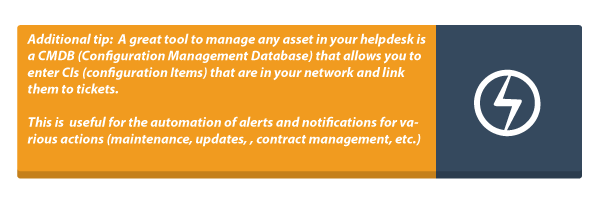
Friday – The Quest for contrinuous improvement
Your new ticket management solution is now implemented, but your work is not yet over. In fact, your helpdesk must continuously be evolving, while trying to surpass the expectations of your clients and users.
It is important to periodically review the needs and the performance that your helpdesk is bringing. That might even be why you’ve decided to change your helpdesk solution last Monday.
As far as improvement processes go, it is important to establish indicators that will measure the performance of your new support solution, especially by doing a comparison of before and after the transition.
Evaluate the elements that are important to you: ticket number, resolution time or response time, for example. You can also during the same exercise determine the points where you can improve.
That continuous improvement process is one of the ways your assistance centre and support level will evolve and improve.

Once that comparison is done and that it has been deemed satisfying, what’s the next step? There may be some functionalities that are not used to their full potential in your helpdesk.
Or there could be departments other than IT in your business that could benefit from such a service management tool. Keep in mind that the opportunities to improve are always there.
It's the Weekend!
Following your new helpdesk transition, hopefully your workload is reduced, better follows ups are available for tickets, your users better informed, knowing the application better and that your Service Level Agreement requirements are met.
All in all, it’s been a busy week, but productive! Customers are happy with the new system and so are your support agents in customer service.
*Without pretending that the implementation always takes 5 days, the objective is to demonstrate that a codeless configuration of such a tool can be done quickly and easily, by following best practices and well-defined processes.



